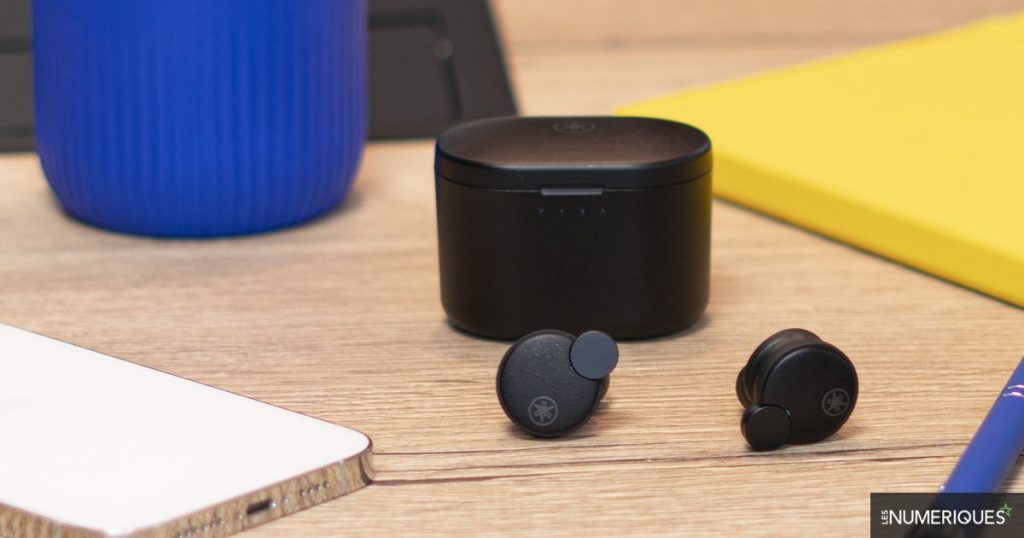
Yamaha TW-E7B review: Massive noise reduction at the cost of questionable comfort

Comfort and support
The TW-E7B adopts a specially designed intrusive in-ear format, not the most comfortable. In fact, to be positioned correctly, the headphones have to be pushed deep into the ear canal, which can result in more than one headphone delay. Additionally, its hefty size doesn’t help matters because in addition to being heavy to carry (7.3g per earphone), the TW-E7B applies a rather unpleasant pressure point at the level of the casing. Therefore, it is difficult to wear it for more than an hour without feeling a noticeable injustice or pain in the ears. Strong obstruction of the auditory canal also causes echo effects with each step that can be disturbing.
Unfortunately, having 5 pairs of silicone tips of different sizes doesn’t really help with the feel, but at least it allows for better insulation efficiency. In addition, the in-ear format allows the headphones to remain in the hollow of the ears, even during a short stride. However, beware of excessive sweating which could be the reason for their good support.

User Experience
Unlike many headphones true wirelessThe TW-E7B does not adopt a touch surface, but remains faithful to the highly reliable physical buttons. Three in number (one on the left and two on the right), they allow you to carry out all the basic commands – not to mention the volume control – however, the number of different actions that need to be performed to get to them is very easily lost, even after a few days of use . In addition, the placement of the buttons is not optimal due to disturbed access by the anti-ear. Some actions are accompanied by tones, not always very pleasant, or voice messages (in English only).
Pairing takes place automatically when you leave the box. You then have to hold two buttons to restart the pairing, a process that must be repeated every time the source is changed, since no multipoint functionality is available. Connectivity is via Bluetooth 5.2 and the headphones are compatible with the SBC, AAC and aptX codecs. The presence sensor allows you to pause or play back music when headphones are removed or replaced in the ears. It also switches to mono mode when one of the headphones is removed.
The Headphones Control app, available on iOS and Android, provides access to various settings, such as the 5-band equalizer, activate active noise reduction and audio processing features. The application also allows you to view the remaining battery level, but it is impossible to change the assignment of commands. Shame.

My voice
Although Yamaha praised the audio performance of its high-end headphones, the TW-E7B clearly disappointed us. The fault is a very unbalanced sound signature and perfect accuracy in mids and highs.
In the first part of the spectrum (from the maximum bass to the mid-range), the TW-E7B shows great control and a certain balance: the bass is faithfully reproduced, with a good level of detail, at least when the active noise reduction is turned off. However, the very slight drop in extreme bass gives a slight downside Bomi In general, but nothing too annoying. When Active Noise Reduction (RBA) is turned on, the intense bass sags more, enhancing this aspect. Bomi, until it “goes inside”, which can have a deafening side when the pieces are too busy at that level. Fortunately, a very good level of detail remains in this case.
Treatment given to the second part of the spectrum (from high averages to extreme triples) is less bright. The TW-E7B shows a real imbalance between highs and mids: the first is very flattering, while the second is hard to discern. The result is a very secluded show, lacking in ventilation: all the instruments and sounds are confined to a small space without any ability to separate themselves from the rest. Thus, the sound stage is presented in a very frontal manner and clearly lacks depth. Additionally, triple folding affects the performance of some instruments such as cymbals, brass or other high-pass filters that lack detail and extension. The high-frequency resolution isn’t the best we’ve heard either.
It is possible to restore a bit of vigor to the trilogy and calm the high mids thanks to the equalizer in the Headphone Control app, but don’t expect miracles…
Listening Care Advanced and Listening Optimizer audio processing technologies don’t add much to the overall offering. The first slightly adjusts the bass level and treble according to the volume; As for the second, we did not detect any noticeable difference by ear.

Active Noise Reduction
If the TW-E7B’s in-ear format significantly affects the feel, it allows the headphones to benefit from excellent passive isolation. Even without Active Noise Reduction turned on, most sounds are very weak. Activating Active Noise Reduction allows you to get a few more decibels until you reach the silence of the cathedral at your fingertips.
More serious noises (engines, ventilation, etc.) are impressively reduced, as are human sounds. Thus, the TW-E7B was able to live up to the best headphones in the field (Apple AirPods Pro (2nd generation), Sony WF-1000XM4, etc.). It is the higher-pitched components that make it possible to understand the person speaking to you or hear sounds like tires slipping on the road or a running tap. Passive isolation also handles non-static and sudden noises well. However, these praises are only valid if the headphones are pushed deep into the ear canal, which greatly affects the sensation of comfort.
The way to listen to ambient sounds is less intelligent. The attenuation is too high to have a conversation properly with the in-ear headphones.

“Incurable web evangelist. Hipster-friendly gamer. Award-winning entrepreneur. Falls down a lot.”
